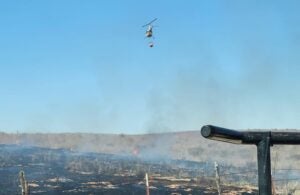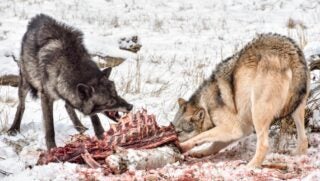On Monday, February 26, Brandon Meier clicked on the live-stream radio in his ag classroom in Canadian, a city of about 2,200 people in the Texas Panhandle. As a volunteer firefighter, Meier understood the inherent danger that a springtime grass fire could pose for neighboring communities and Canadian. So when the FFA chapter’s president, Jack Craft, a volunteer firefighter in a neighboring town, entered the classroom and announced that wildfires had ignited in the nearby towns of Pampa and Stinnet, Meier’s lesson priorities of the day shifted to making sure that his classroom was keeping up with the fire’s growth, and the springtime winds that the Panhandle is so well known for.
Meier, a native of Darrouzett, Texas, grew up tending to cattle and cultivating wheat, corn, and milo. His academic journey naturally led him to a plant and soil sciences degree and then to his role as volunteer fire chief in Darrouzett. However, when he was offered a position at Canadian High School, his career took a turn that he never anticipated. Along with many other agriculture teachers, he has found himself imparting real-life, hands-on experiences to his students for the past eight years, a role reversal that has proven challenging and rewarding.
It was not unusual for him to dial his students into current events, and rural youth come prepared with a different kind of skill sets than your average students. But nobody anticipated how quickly this spring’s Grapevine and Smokehouse Creek fires would grow in just a few days — nor how significant the devastation would be on farms, ranches, and communities across the Texas Panhandle and Oklahoma in the coming weeks.

“We listened to it all day because it was blowing in this direction,” Meier explained. “I told the kids that we needed to look forward and plan.”
When the fire got close to Miami, a town barely 20 miles from Candiana, Meier’s classroom took a back seat for Craft as he headed to Roberts County to fight flames that were encroaching on nearby communities. Dedicated efforts effectively stopped the blaze, but Meier kept an uneasy eye on the forecast and saw that high winds were in the forecast.
Meier recognized that the high winds would not only reignite recently-controlled fires, but potentially send flames the direction of his students and classroom.
“I drew a line straight from where that fire was. And guess what town was in its direct path? Canadian,” said Meier. “All day in school again, I had the radios going again, including my fire radio, because the fire had started again, and it was fixing to jump back over the road.”
Despite the growing disaster, students sat in Meier’s classroom, trusting their advisor to keep them safe and informed. That whole morning, Meier says that he stayed in contact with firefighters on the scene. Then, the inevitable happened — the fire jumped nearby U.S. 83, and school was canceled. Eager to help in fighting the blaze, Meier called his principal as soon as his kids were out of harm’s way and then jumped on a fire truck himself.
@bameier1 I want to personally Shout out@Jack craft it was an honor fighting this beast beside you as a Fire chief and your Ag Teacher! Your making many people proud stepping up like this and helping! Doing the job not many step up to VOLUNTEER and do! #firefighter #2024wildfire #wildfire #teachers #student #fire #fyp #sendit #proud ♬ original sound – CFB_Daily
Grass fires are typically less intense and shorter-lived than forest fires. But they can spread exponentially faster, outrunning both firefighting resources and burning everything in their path. The Panhandle fires were fueled by grass and forage that had been built by moisture last summer, coupled with a landscape dotted by unharvested or grazed Conservation Reserve Program acres. When combined with the added high winds, the conditions were perfect for a fast-moving, hot-burning fire.
Meier’s crew headed to fight the flames that had reached the Canadian Feedyards, but they soon realized that they weren’t saving anything in the fire’s path.
“We were surrounded by flames, and we realized that we had to change our strategy, because this wasn’t an offensive fire. We were putting a Band-Aid on a bullet hole,” said Meier. “I told my guys that we had to get to Glazier.”
The town of Glazier is a small, unincorporated community in Hemphill County, Texas. It’s an 11-minute drive from Canadian, where Meier says there are about 40 houses. So, the crews loaded their engines, and headed to Hemphill County, battling 50- to 60-mile-per-hour winds that fed flames.
Thanks to quick thinking and action, firefighters, including those on Meier’s crew, were able to save all structures in Hemphill County.
In the midst of the blaze, what couldn’t be saved was Canadian FFA’s barn. Meier explains that while the program’s buffalo (who now lives at his house), a wooden shack, and many other school buildings were left standing, much of the agriculture program’s welding supplies, metal barns, show barn, and other supplies were destroyed during the fire.
@bameier1 Due to the wildfires in the Panhandle the Canadian FFA has lost our FFA Ag farm. Big thanks to the fire depts for all they have done! #ffa #ag #farm #wildfire #texas #school #smokehousecreekfire #2024wildfires #fyp #firetruck ♬ Sad Music – Max-Music
“We didn’t have the best facilities out there. But we had any tool, any item you could think of related to stock shows. Thousands of dollars of equipment and tools were in our barn that burned down,” explained Meier. “I can’t even tell you how much it will cost to replace the supplies and the new barn.”
Amid the shambles of the FFA barn, Meier found what was left of a rabbit.
“When you’re fighting a fire, you see some pretty horrific things. Cattle walking up the street burned, you’ll see little flame balls in the grass, and those are rabbits on fire,” Meier said. “I think one ran in there, hunkered down under the storage lockers, and caught the whole thing on fire.”
Meanwhile, welding equipment and supplies helped heat and fuel the blaze in other areas of the FFA’s land lab.
Despite the setback and loss of equipment, members of the Canadian FFA have been back to “business as usual,” or at least as usual as possible.
“A few kids missed out on the first few contests, helping local ranchers where they could. But they’re competing now. It’s important to see us pick up and keep going,” Meier said. “Believe it or not, I had canceled the contest the day I was fighting the fire, and I had kids sad they’d missed out on the contest. It’s their job, and they wanted to do it.”
One student, whose family had lost some of their longhorn herd, showed up the first day back to school and told Meier that she wanted to write thank you letters to every fire department that helped fight the Panhandle fires. She wrote over 100 thank you letters and sent them out that same day.
“It’s how these kids are. They’re thankful, they give back, and they show their appreciation,” Meier remarked. “I have another kid here that I was driving through some pasture with, and he asked about the number of volunteer hours he’d worked in school. He had over 100 hours of community service already.”
Canadian FFA’s ag program alongside the Panhandle has a long road to recovery. With forage burned off of the rangeland, Meier says that new grass is trying to sprout up. But, with windy days, “It’s like the Sahara desert. What grass is trying to grow is getting beat up by the sand.”
Alongside efforts to get feed and supplies to ranchers, initiatives to help the FFA program rebuild were launched last month. The Panhandle FFA Booster Club will donate the proceeds from a T-shirt created to help the Canadian FFA rebuild its program.
Ranch Raised, a Montana-based brand of ag-centric clothing, has launched a Texas line. All proceeds will be donated to the Canadian FFA.
FFA programs around Texas have stepped up to help raise funds. Walsh School District’s Annual Calf Fry on April 11 aims to donate their proceeds to the Canadian FFA chapter. Motley County FFA also raised funds to help through a barbeque.
Wildfires in the Panhandle destroyed 500 structures during a three-week battle to contain them. Approximately 1,058,482 acres were scorched before the fires were successfully contained, and the Smokehouse Creek Fire became the largest fire on record in Texas history. The fires are also considered responsible for the deaths of three people and approximately 7,000 to 10,000 head of cattle.
AgriLife Extension reported the supply points received $4.4 million in commodity donations and $2.85 million in hay, feed, and fencing supplies as of April 10. And donations have continued to trickle in.
The road to recovery for farmers, ranchers, and FFA members who lost parts of their communities, family operations, and FFA programs will be a long one. But, the process of rebuilding has started for many, while others, such as the Canadian FFA wait for insurance, school, and funding approvals to go through.
Heidi Crnkovic, is the Associate Editor for AGDAILY. She is a New Mexico native with deep-seated roots in the Southwest and a passion for all things agriculture.



